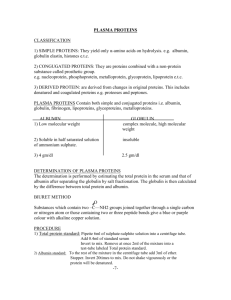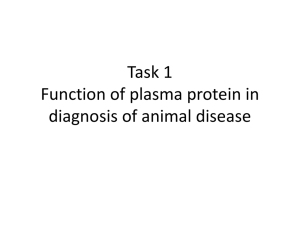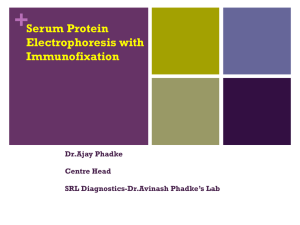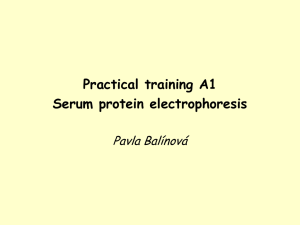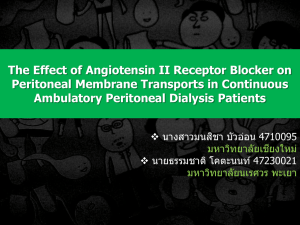Electrophoresis
advertisement
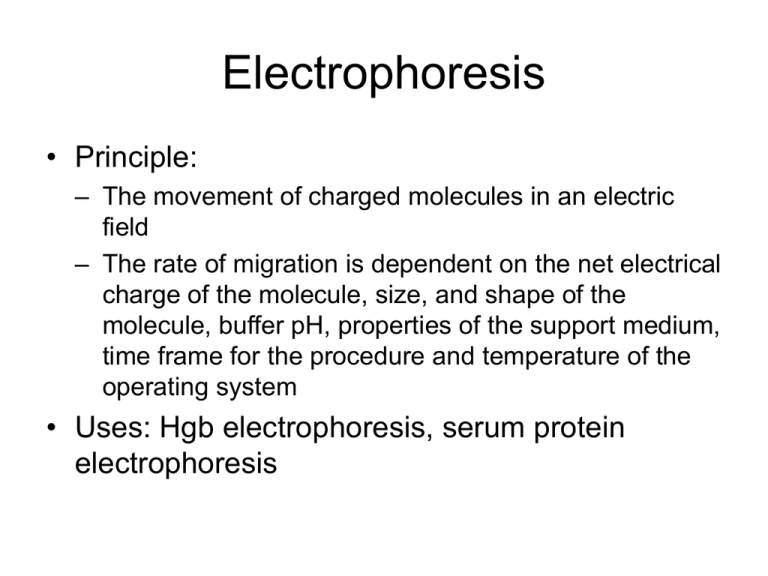
Electrophoresis • Principle: – The movement of charged molecules in an electric field – The rate of migration is dependent on the net electrical charge of the molecule, size, and shape of the molecule, buffer pH, properties of the support medium, time frame for the procedure and temperature of the operating system • Uses: Hgb electrophoresis, serum protein electrophoresis Cover – + Power supply Anode Insulating plate Buffer Cathode Electrophoresis support medium In an electrophoresis system, charged molecules move through a support medium because of forces exerted by an electric field. Albumin a1 a2 b g Migration distance This serum protein electrophoresis demonstrates a normal pattern, with the largest peak for albumin. Normal Normal values may vary from lab to lab. Serum protein electrophoresis Total serum protein Amount in grams per deciliter (g/dL) Albumin: 58%–74% 3.5–5.5 Alpha-1 globulin: 2.0%–3.5% 0.2–0.4 Alpha-2 globulin: 5.4%–10.6% 0.5–0.9 Beta globulin: 7%–14% 0.6–1.1 Gamma globulin: 8%–18% 0.7–1.7 Principali componenti delle frazioni elettroforetiche I • Albumin. In addition to carrying substances through the bloodstream, albumin proteins help keep fluid from leaking out of tiny blood vessels (capillaries). Albumin may also help with tissue growth and healing. More than half of the protein in blood serum is albumin. • Alpha-1 globulin. High-density lipoprotein (HDL), the “good” type of cholesterol, is included in this fraction. • Alpha-2 globulin. A protein called haptoglobin, that binds with hemoglobin, is included in the alpha-2 globulin fraction. Principali componenti delle frazioni elettroforetiche II • Beta globulin. In addition to carrying substances through the bloodstream, beta globulin proteins help fight infection. One protein (transferrin) included in this fraction helps carry iron in the blood. Another protein (complement C3) is needed to destroy bacteria. • Gamma globulin. These proteins are important in preventing and fighting infection. Some gamma globulins bind to foreign substances (such as bacteria or viruses), causing them to be destroyed by the immune system. (See an illustration of the immune system.) Gamma globulins are also called antibodies. High values • An increase in the percentage of albumin can indicate a severe loss of water from the bloodstream (dehydration). • An increase in the percentage of alpha-1 globulin may be caused bysystemic lupus erythematosus, rheumatoid arthritis, pregnancy, infection, or cancer. • An increase in the percentage of alpha-2 globulin may be caused by systemic lupus erythematosus, rheumatoid arthritis, cancer, kidney disease, heart attack, or a long-term (chronic) infection (such as tuberculosis). • An increase in the percentage of beta globulin may be caused by liver disease (such as cirrhosis), anemia, or an increased lipid level. • An increase in the percentage of gamma globulin may be caused by a chronic infection, anautoimmune disease, some types of leukemia, multiple myeloma, Waldenstrom's macroglobulinemia, liver disease, or Hodgkin's disease. An increase can also occur normally with aging (a condition called monoclonal gammopathy of unknown significance). Low values • A decrease in the percentage of albumin may be caused by a poor diet (malnutrition), severe burns, liver or kidney disease, systemic lupus erythematosus, rheumatoid arthritis, Hodgkin's disease, cancer that has spread in the body, or diseases (such assprue or Crohn's disease) that prevent the intestines from absorbing the nutrients from food. • A decrease in the percentage of alpha-1 globulin may be caused by liver or kidney disease or by an inherited condition that can cause emphysema. • A decrease in the percentage of alpha-2 globulin may be caused by liver damage, leukemia, hemolytic anemia, hypothyroidism, or Wilson's disease. • A decrease in the percentage of beta globulin may be caused by kidney disease or problems with the blood-clotting process. • A decrease in the percentage of gamma globulin may be caused by kidney disease or problems of the immune system (low amount of antibodies). Laboratory investigations of liver disease Serum protein electrophoresis • Characteristic findings in liver disease include reduction in albumin and increase in gamma globulin in chronic liver disease (particularly auto-immune chronic hepatitis and alcoholic cirrhosis) • Decrease in alpha-1 globulins (alpha-1 antitrypsin deficiency) • Iincrease in alpha-globulins (prolonged cholestasis) • SERUM PROTEIN ELECTROPHORESIS (SPE) Albumin alpha1 alpha2 beta gamma Pt’s SPE NOTE: Instead of the normal polyclonal distribution, Ig is distributed in a monoclonal fashion. This is called a “monoclonal gammopathy.” but first, we must provide that this “band of restricted mobility” is really a monoclonal antibody. SPE tracing TO PROVE THAT THE “BAND OF RESTRICTED MOBILITY” IS TRULY A MONOCLONAL ANTIBODY, WE MUST PERFORM IMMUNOFIXATION ELECTROPHORESIS (IFE). IFE: - run the pt’s serum in 6 lanes. - In the first lane after electrophoresis, we precipitate all of the serum proteins with a polyclonal antiserum or chemical precipitation with tricholoracetic acid (TCA). This pattern looks like the normal SPE. IMMUNOFIXATION ELECTROPHORESIS (IFE) - In lanes 2 through 6, we overlay each lane with specific antisera. Lane G A M K L anti-serum anti-gamma heavy chain anti-alpha heavy chain anti-mu heavy chain anti-kappa light chain anti-lambda light chain Note: The antisera precipitate the Ig’s present in the lanes. SP G A M K L - + anti-mu anti-kappa anti-lambda SP anti-alpha poly-specific anti-gamma Normal Ig distribution: “polyclonal” pattern G A M K L - Ag - Ab complexes “precipitate” in gel + - other proteins in each lane are “washed” away Polyclonal pattern INTERPRETATION: The “M-spike” on the SPE by IFE is composed of monoclonal IgG kappa

